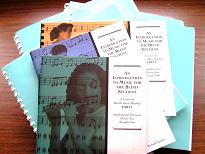 AN INTRODUCTION TO MUSIC FOR THE BLIND STUDENT,
A Course in Music and Braille Music Reading - Part I
is a flexible course which
equips the mainstream educator with no prior experience with braille to teach
and learn music Braille The author, Richard Taesch, is a lifelong music educator
and guitarist who is certified by the Library of Congress as a Braille music
transcriber. He headed the Braille Music Division of the Southern California
Conservatory of Music and chaired the guitar department.
AN INTRODUCTION TO MUSIC FOR THE BLIND STUDENT,
A Course in Music and Braille Music Reading - Part I
is a flexible course which
equips the mainstream educator with no prior experience with braille to teach
and learn music Braille The author, Richard Taesch, is a lifelong music educator
and guitarist who is certified by the Library of Congress as a Braille music
transcriber. He headed the Braille Music Division of the Southern California
Conservatory of Music and chaired the guitar department.
Description of the Course
Braille music reading has traditionally been taught
as a translation process from print music as the sighted musician views it.
This course differs from the norm in that it is a true instructional course-curriculum
in music fundamentals, music reading, sight singing, theory, and ear-training
using the Braille Music Code as the medium. Print music is considered
secondary, and included for the convenience of the sighted teacher or tutor.
It is, therefore, possible for a sighted (or blind)
musician to administer or to study this work without prior knowledge of the
Braille music code. It is also intended that a sighted teacher, parent, or tutor
with little or no knowledge of Braille or conventional print music, may guide
a blind student through this course. Teacher training is also a natural application
for the course. Much testing by correspondence has been conducted, and the course
was part of the official curriculum at Southern California Conservatory
of Music's Braille Music Division for many years.
Content Description
The course is divided into two Parts. Part I (Phases
One through Four) is "ground level," and covers rudiments through intermediate
melodic interpretation and key signatures. Part I is written into three separate
print volumes- Lessons; Lesson Exercises; Supplemental Exercises. The Braille
edition exists in 4 Braille volumes. All three print volumes are integrated
and used simultaneously, however, each may also be used separately depending
upon individual application.
The course is intended to teach the essentials of music
reading regardless of the student's chosen instrument. The piano is considered
as a basic tool common to all instrumentalists.
First Volume: Lessons
91 print pages
Each Phase concludes with a lesson summary as an outline.
This is intended to give experienced music teachers the option of flexibility,
while guiding them through critical essentials specific to the Braille Music
Code.
Phase One addresses rudiments of music in five
separate lessons. General content covers introductory ear training, and an introduction
to solfege (sight singing) by reading Braille scale step numbers only. Structural
concepts of scales and intervals in the form of Musical Arithmetic is also a
part of Phase One.
Phase Two introduces true Braille music notation
and the Braille Music Code. Notation covering the first five notes of the C
Major Scale is taught in four lessons. Lesson 4 introduces the concept of Melodic
Dictation, whereby the blind student is required to write the notes on the Braille
writer as they are played by the teacher or tutor.
Phase Three introduces the Braille melody line
incorporating such concepts as time signatures, note duration, repeat signs,
piano fingerings, notes in the third & fifth octave, accidentals, major and
minor scales, and other essentials needed at this level.
Phase Four covers key signatures and other musical
devices such as ties, phrase marks, use of the Braille music hyphen, and composition
and formatting techniques.
Appendix contains Theory Examinations pertinent
to all four Phases, and concludes with a detailed Index of the text.
Second Volume: Lesson Exercises
9 print pages
This volume includes the Lesson Exercises that are
assigned in the Lessons text. A "facsimile" of the Braille page as the Braille
reader sees it is shown on the left page with equivalent print music on the
right page. Each Braille facsimile page includes print fonts that point out
each new Braille sign as it is introduced in the lessons. The sighted teacher
uses these fonts to reference their place on the Braille page.
Third Volume: Supplemental Exercises
67 print pages
This volume is composed of graded supplemental material
intended to expand exercise opportunities, and serves to illustrate concepts
presented in the course. It may be used independently of the rest of the course,
however, it functions as an extension of the course as it is written. There
are sixty-seven print pages and one Braille volume. All exercises have been
composed by the author with the exception of a section called "Duets and Classic
Themes".
Some exercises are used for sight singing and playing,
others are for singing only or playing only. Duets are common, and right and
left hand fingered versions are plentiful. The text concludes with a section
of scale exercises for comprehensive note study and review. Each print music
exercise is immediately followed by simulated Braille print dots.